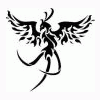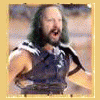Classifica
Contenuto popolare
Contenuti visualizzati con la più alta reputazione il 22/01/2011 in tutte le aree
-
Sì, puoi farlo. Tuttavia attento che Spontaneous Wounder dice "You can use your spellcasting ability to spontaneously cast inflict spells (from your class spell list) just as a cleric can". Quindi questo vuol dire che non puoi convertire i tuoi incantesimi in qualsiasi incantesimo infliggi, ma solo in quelli che compaiono nella tua lista degli incantesimi di classe, ovvero i tre infliggi ottenuti dal dominio della Distruzione grazie ad Arcane Disciple. Strettamente RAW, questa mossa è possibile solo prendendo il talento Arcane Disciple (che dice espressamente "Add the chosen domain's spells to your class list of arcane spells). Mentre non sarebbe possibile ottenendo un normale accesso al dominio, ad esempio tramite la classe di prestigio del contemplativo (infatti in quel caso il testo non dice che aggiungi gli incantesimi alla tua lista di classe, ti dice che puoi preparare un incantesimo di dominio per livello in alternativa ai tuoi normali incantesimi nel caso degli incantatori non spontanei o che puoi imparare un incantesimo di dominio come incantesimo conosciuto nel caso degli inantatori spontanei).2 punti
-
Introduzione Quante volte vi è capitato di vedere qualcuno (anche voistessi)...? «Chiedersi se il proprio pg fosse più forte di quello degli altri» «Lamentarsi di un giocatore che sembrava prestare troppa attenzione al combattimento e alla scheda» «Realizzare, come DM, di non essere in grado di gestire il personaggio di un determinato giocatore» «Vietare ai propri giocatori una determinata combinazione, perché ritenuta troppo "forte"» Se la risposta è un numero intero strettamente positivo, allora avete bisogno di continuare la lettura di questo topic. Altrimenti, sappiate che continuare a leggere non può farvi male. Questo topic nasce dall'esigenza di fare chiarezza su quelli che dovrebbero essere i presupposti basilari per un corretto sviluppo e svilgimento di una campagna non EUMATE di D&D 3.x. Il topic espone in primo luogo il mio personale punto di vista, ma sono bene accetti consigli ed eventuali critiche. Legenda - Generic PoV - Player's PoV - DM's PoV - Roles Abbreviazioni1 punto
-
Dalle RotG (Rules of the Game): è in inglese, io me lo tradussi per il mio avariel di una vecchia campagna, ma non ritrovo il file. Stalling and Freefalling Stalling represents the failure of a flying creature's wings (or other motive agent) to keep the creature aloft. The rules are a little sketchy when it comes to what happened during a stall, so here are some unofficial suggestions. A stalling creature falls, but it wings provide considerable drag and tend to slow the creature's fall. As noted earlier, a creature falls 150 feet during the first round spent stalling, and it falls 300 feet each round thereafter. Wingless flyers that stall still have some residual lift and fall more slowly than non-flyers. A flying creature that cannot maintain its minimum forward speed because it has been rendered unconscious, has become paralyzed, has become magically held, or becomes unable to move for some other reason stalls at the beginning of its first turn after the debilitating effect occurs. A stalling creature can take no actions, except to recover from the stall. It loses its Dexterity bonus to Armor Class (if any) while stalling. As noted earlier, recovering from a stall requires a Reflex save (DC 20). A stalling creature falls more or less straight down, but it also tumbles and spins erratically. Melee or ranged attacks made against a stalling creature have a 20% miss chance. A nonflyer (or flyer falling through the air) freefalls rather than stalls. A creature in freefall drops 500 feet the first round and 1,000 feet each round thereafter. While in freefall, a creature can attempt a single action each round. It must make a Dexterity or Strength check (creature's choice, DC 15) to avoid dropping any item it tries to use. Spellcasting is possible, but doing so requires a Concentration check (DC 15 + spell level) and if the spell has a material component, the creature must first check to see if it drops the component. Deliberately Freefalling: A flying creature can simply stop flying and allow itself to drop like a stone. Exiting a freefall requires a full-round action (during which the creature falls 500 or 1,000 feet). A creature with Perfect maneuverability exits a freefall automatically, less maneuverable creatures require a Reflex save (DC 20). If the check fails, the creature stalls (even if it does not have a minimum forward speed), though during its next turn it can attempt to recover from the stall after falling 300 feet. A creature with average, poor, or clumsy maneuverability suffers 3d6 points of nonlethal damage when it exits a freefall (or when it stalls from a failed attempt to leave freefall) due to the stress on its body. A freefalling creature with a fly speed can automatically recover from a freefall if it receives a feather fall spell, but only after falling 60 feet; the creature suffers no damage from the recovery. Fast Freefalls: A creature with a fly speed can propel itself downward as a move action, adding up to twice its flying speed to the distance it freefalls. A creature with Perfect maneuverability can make a fast freefall automatically, while less maneuverable creatures require a Reflex save (DC 15). If the save fails, the creature stalls. On a successful check the creature fast freefalls for a full round. Catching: As a full-round action, a flyer can catch a freefalling creature or object, or a stalling creature, provided that the falling creature or object is at least one size category smaller than the creature attempting the catch. To make the catch, the creature must make a successful melee touch attack to grab the falling creature or object (a creature can voluntarily forego any Dexterity bonus to AC if desired). If the grab succeeds, the catching creature must make a Reflex save (DC 25) to keep flying. If the save fails by 4 or less, the catcher drops the falling creature or object. If the save fails by 5 or more, the catcher drops the falling creature or object and stalls if it has a minimum forward speed. If the catcher does not have a minimum forward speed, it falls 1d4x10 feet. Obstacles and Collisions Because flying creatures cannot always change direction when they wish to, they must take great care to avoid blundering into obstacles or into other creatures. Maneuvering PastObstacles: To turn and avoid an obstacle at its own altitude, a flying creature must be able to turn in place. If it cannot turn in place, it needs at least 5 feet of space between it and the obstacle if it wishes to turn to avoid a collision (because in an aerial turn you move into the square ahead of you and then turn left or right 45° ). It cannot move diagonally past a corner in the air or on the ground, so any turn you make must carry you past an obstacle's corner before you can fly past it. If turning to avoid an obstacle isn't possible, it may be possible to climb over or dive under the obstacle. A creature with maximum up or down angle of 45° needs at least 5 feet of clear space between it and an obstacle for every 5 feet it must climb or dive to get over or under the obstacle (you can't move past a corner on a diagonal, even when climbing or diving). A creature with a maximum up or down angle of 60° needs at least 5 feet of clear space between it and an obstacle for every 10 feet it must climb or dive to get over or under the obstacle. Maneuvering PastCreatures: Flying past another creature works much like flying past an obstacle except that you can move on a diagonal to get past a creature. This makes it slightly easier to pass by without colliding. Colliding with an Obstacle: Here's another place where the rules don't help much, so here are some more unofficial suggestions. If you fly into an obstacle and you cannot land there, you must make a Reflex save (DC 15) to avoid damage. If you fail the save, you and the object you strike take damage as though an object of your weight fell a distance equal to half your flying speed before you hit. (If it isn't clear what your speed before the collision was, use your flying speed during your previous turn.) If the object you hit has a hardness of 6 or less, you take nonlethal damage (the object takes normal damage). Your flying movement stops when you strike, forcing you to stall (even if you don't have a minimum forward speed) and fall straight down. If you're still conscious after the collision, you can make Climb check (DC = surface's DC + 20) to catch yourself and keep from falling. If the surface is sloped (see the Climb skill description), the Climb DC to catch yourself is lower (DC = slope's DC + 10). Colliding with a Creature: Here's another place where the rules don't help much, so you can use these unofficial suggestions. You can freely pass through your allies' spaces in the air just as you can on the ground. If you fly into a creature that is not your ally, you effectively attempt to overrun it. You can execute a bull rush against the creature instead, if you wish. An overrun or bull rush normally requires a standard action. If you accidentally enter an enemy's space you must make a Reflex save (DC 15); if you fail, you stall (even if you don't have a minimum forward speed). If you succeed, you can continue with your accidental bull rush or overrun, but you suffer a -4 penalty to all the opposed checks you make to resolve the bull rush or overrun. As with an overrun attack, the creature can decide not to block your movement, though this might cause the creature to stall (see the section on overruns). If so, you simply move through its space (even if you decide to bull rush the creature). You cannot stop in another creature's square, however, and if your speed isn't sufficient to carry you through the other creature's space, you must attempt an overrun or bull rush. If the creature is too small to overrun, you must try to bull rush it instead if you can't pass through its space. If the creature is too big to overrun, you strike it just as if it were an obstacle, and you and the creature take nonlethal damage. Both you and the creature you strike make Reflex saves (DC 15) to avoid damage, but the creature you strike gets a +4 bonus for each size category it is bigger than you. You stall just as if you struck an obstacle. The creature you strike stalls if it fails its Reflex save. If you are at least three size categories smaller than the creature whose space you are entering (or if you are Tiny, Diminutive, or Fine size) you can enter the creature's space without colliding, bull rushing, or overrunning, but entering the creature's space provokes an attack of opportunity. Likewise, if you are at least three size categories smaller than the creature whose space you are entering, you also can enter the creature's space without colliding, bull rushing, or overrunning, but entering the creature's space provokes an attack of opportunity. Fonte: http://www.wizards.com/default.asp?x=dnd/rg/20040706a ciao dal nonno1 punto
-
Perché il mago è tra le classi più potenti del gioco. Anche se rimanesse indietro di uno o due livelli, l'esperienza di gioco non ne risentirebbe. Il guerriero invece già ha i suoi problemi, già è inferiore a un mago del suo stesso livello, ci manca solo che gli fai perdere i PE e siamo a posto.1 punto
-
La soglia magica si applica ai mostri. Non c'entra niente col numero di oggetti magici, ma solo col livello del PNG. Nel caso in cui un mostro/png abbiano un oggetto magico, possono utilizzarlo, ma il bonus di potenziamento da aggiungere per le stat che va ad influenzare si sottrae dalla soglia magica. Per esempio se un PNG di 6° livello (soglia magica +1) viene data una spada magica +2, lui ottiene un bonus aggiuntivo ai tiri per colpire e ai danni di quei poteri che usano l'arma di +1 (= 2 potenziamento oggetto - 1 soglia magica).1 punto
-
Quella dell'allineamento è sempre stata una patata bollente. Io, come master, ho sempre preso la descrizione degli allineamenti come guida, più che altro, soprattutto per quello che riguarda la distinzione tra legale e caotico. Questo perchè i tratti legale/caotico sono sempre stati molto ambigui. Ad esempio, un caotico buono che vive, chessò, a Silverymoon, dove tutto fila liscio e quindi non sente la necessità di "infrangere" nessuna legge allora dopo un po' sarà da considerarsi legale solo perchè le regole della città coincidono con il suo credo!??! Nel manuale, come caotico buono, c'è l'esempio di Robin Hood se non sbaglio. Quindi, Robin Hood, una volta sconfitto il suo nemico Nottingham, diventerebbe legale buono perchè non avrebbe più bisogno di rubare ai ricchi per donare ai poveri!? Oppure, un legale buono che capita nel Thay e vede schiavi in vendita ad un mercato, cosa dovrebbe fare!? Dovrebbe ribellarsi perchè la sua concezione di "legale buono" non gli consente di accettare la schiavitù!? Oppure dovrebbe accettare quella situazione perchè lo schiavismo è considerato legale nel Thay!? O, ancora, un legale buono che ruba ogni giorno un po' di cibo perchè ridotto alla fame, diventerebbe caotico!? Sarebbe una situazione accettabile dovuta alle necessità del PG!? Insomma, quand'è che un master può dire ad un giocatore con assoluta certezza: "Guarda tu sei caotico buono ma ti stai comportando da legale buono da fin troppo tempo?". Secondo me, quasi mai. Questo perchè se si gioca ad una ambientazione le sfumature sono così tante e soggettive che risulta praticamente impossibile distinguerle. Questo, a meno che il giocatore non si imepgni realmente ad agire contrariamente all'allineamento che ha scritto sopra la sua scheda (ma si tratta di un altro discorso). Oltretutto, se si legge attentamente il manuale dei Reami, per esempio, si scoprono tantissimi riferimenti a personaggi teoricamente "buoni" che compiono azioni che, ogni tanto, sembrano un po' estreme. Una cosa è certa però: il master non può dire al giocatore come personalizzare il suo personaggio. Se io, giocatore, voglio creare uno stregone poco carismatico, poco intelligente ma con molti PF e che si diverte ad andare in corpo a corpo a mani nude a lanciare Mani Brucianti a tutti, dovrei essere in grado di farlo. Se poi quel PG sarà in grado di sopravvivere all'avventura questo non si può sapere. Certo è che un Cherico di Tyr che predilige il combattimento non è assolutamente strano, anzi!!! Ergo, il master dovrebbe calibrare gli scontri in base al gruppo che gioca e senza presupporre un comportamento stereotipato da parte di una classe. Poi, starà ai personaggi stessi inventarsi qualcosa per vincere quello scontro. Poi esistono sempre le dovute eccezioni eh. Se un mago legale buono, con la possibilità di salvare tutti i suoi compagni da morte certa, rimanesse invece a combattere uno scontro, causando la morte del suo party e poi salvasse solo se stesso... ecco, magari si potrebbe discutere se una situazione del genere dovesse ripetersi più volte e tale mago dovesse comportarsi nuovamente da egoista, causando problemi ai restanti membri del gruppo. In quel caso, coem master interverrei sicuramente, o facendogli cambiare attitudine, o facendogli cambiare allineamento (ma probabilmente, ancora prima, verrebbe cacciato dal gruppo dai suoi stessi compagni).1 punto
Questa classifica è impostata Roma/GMT+01:00




